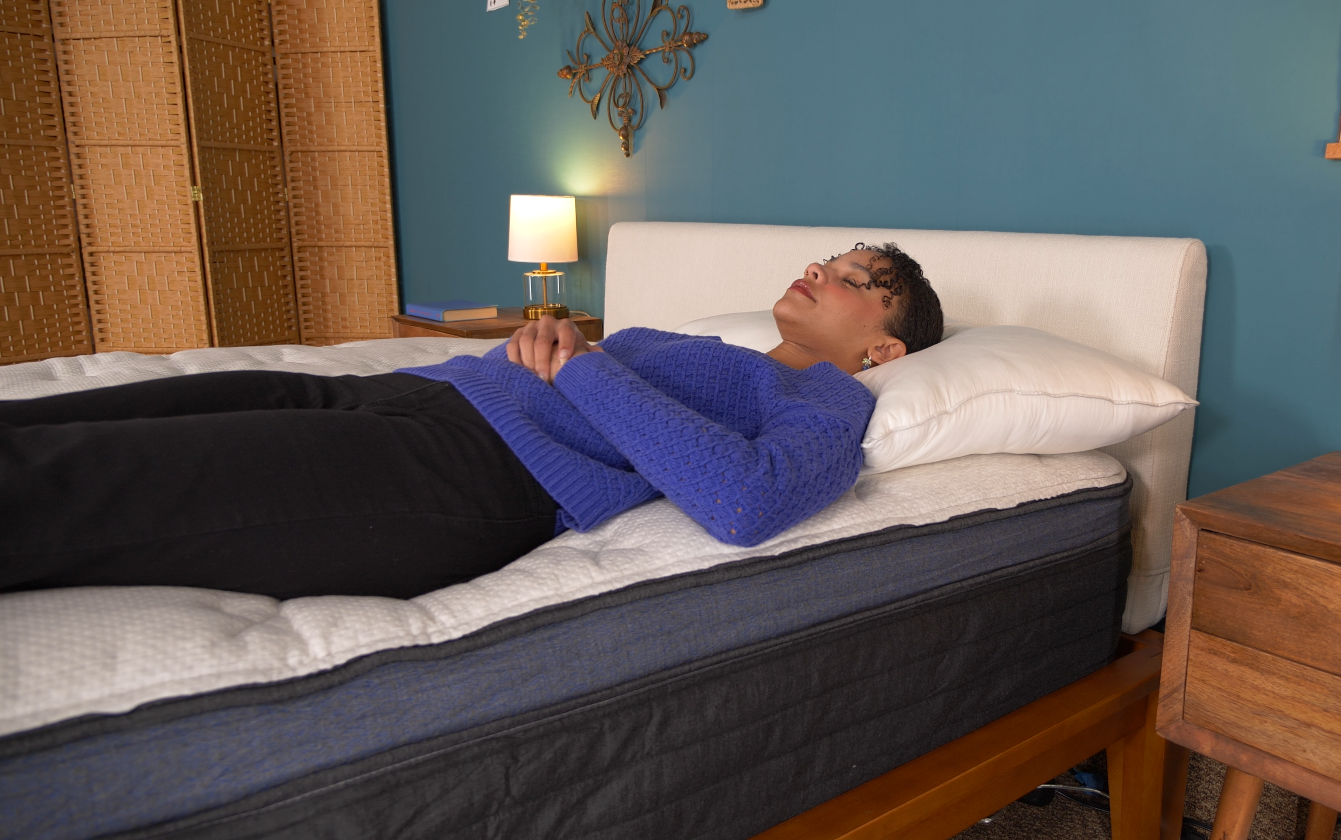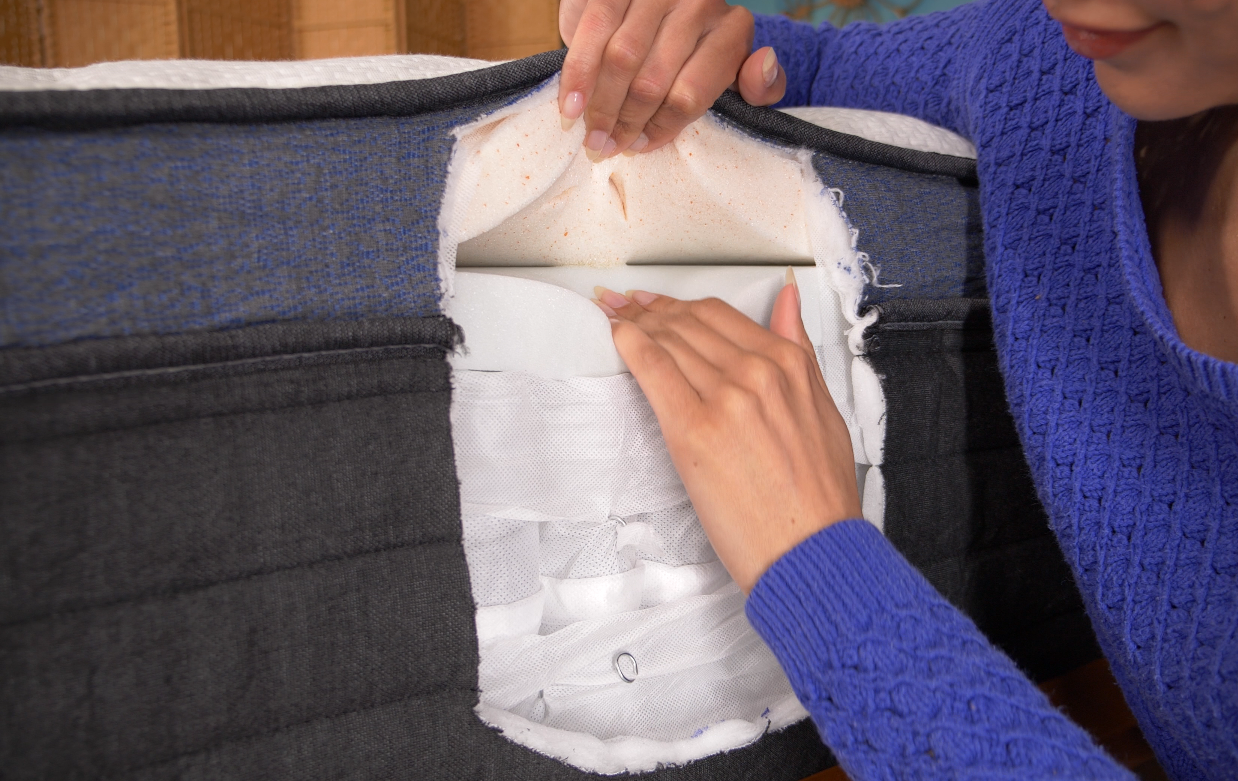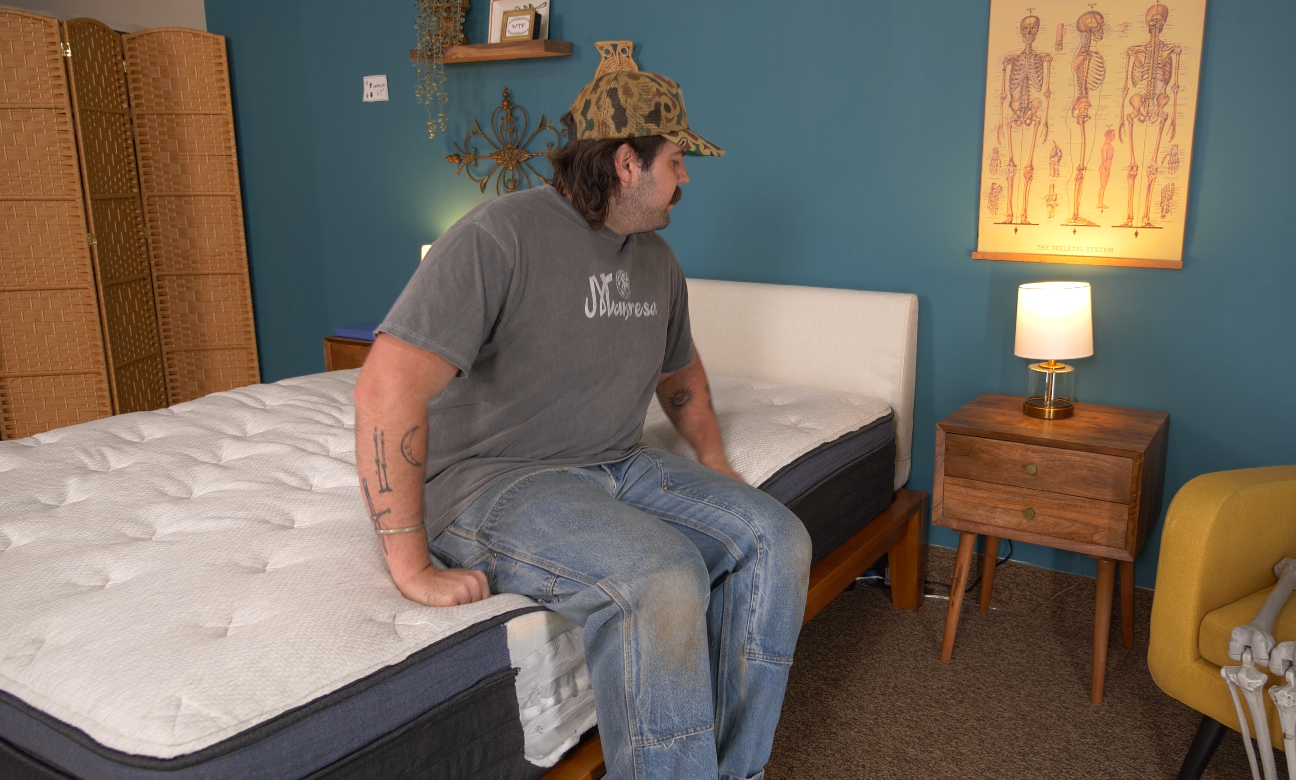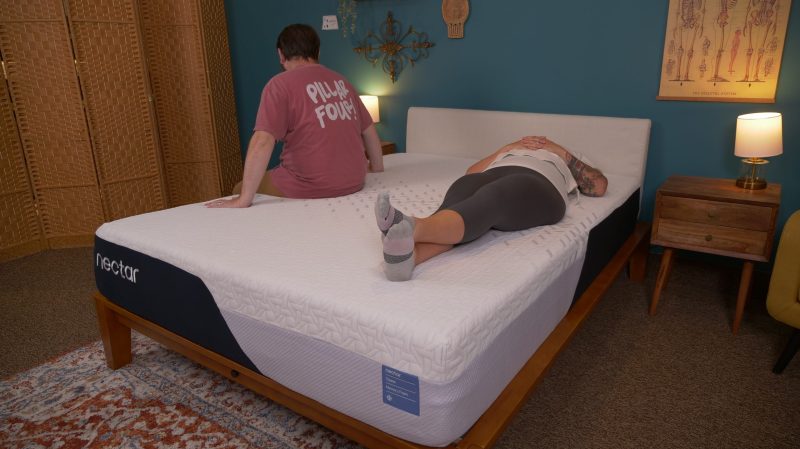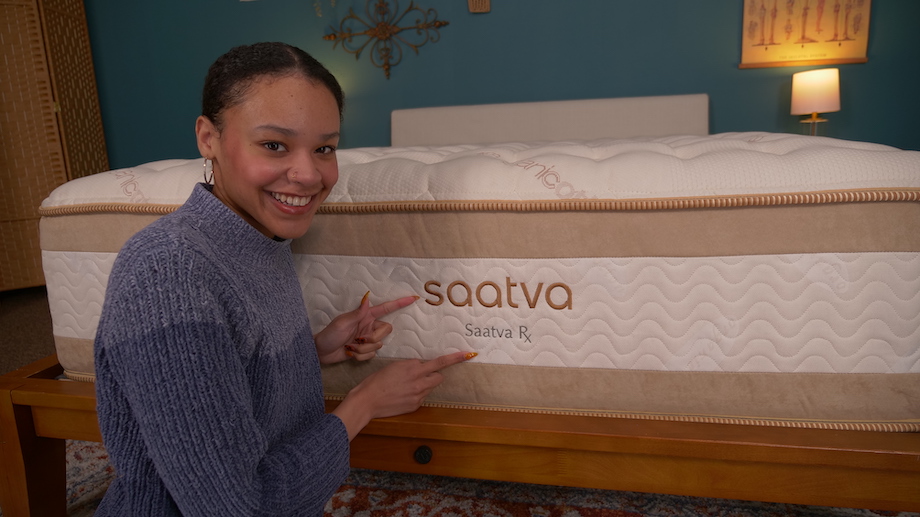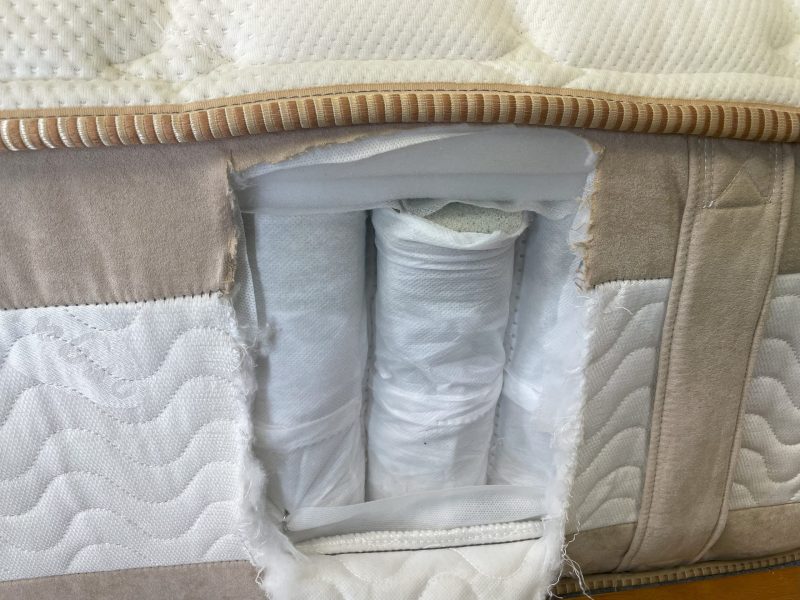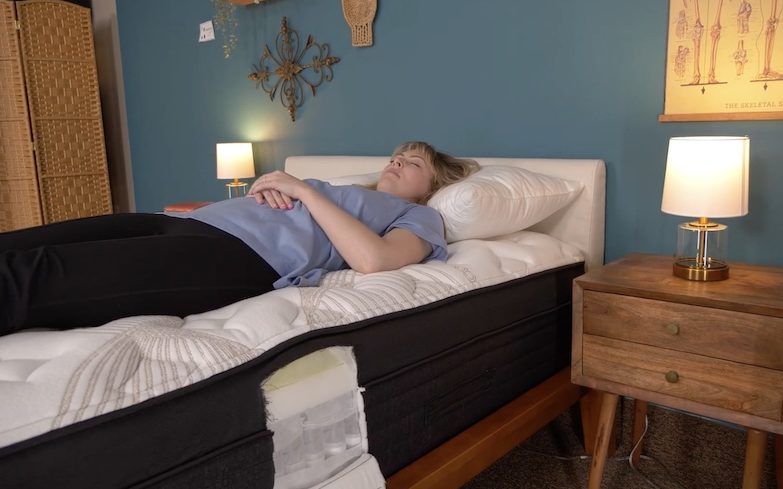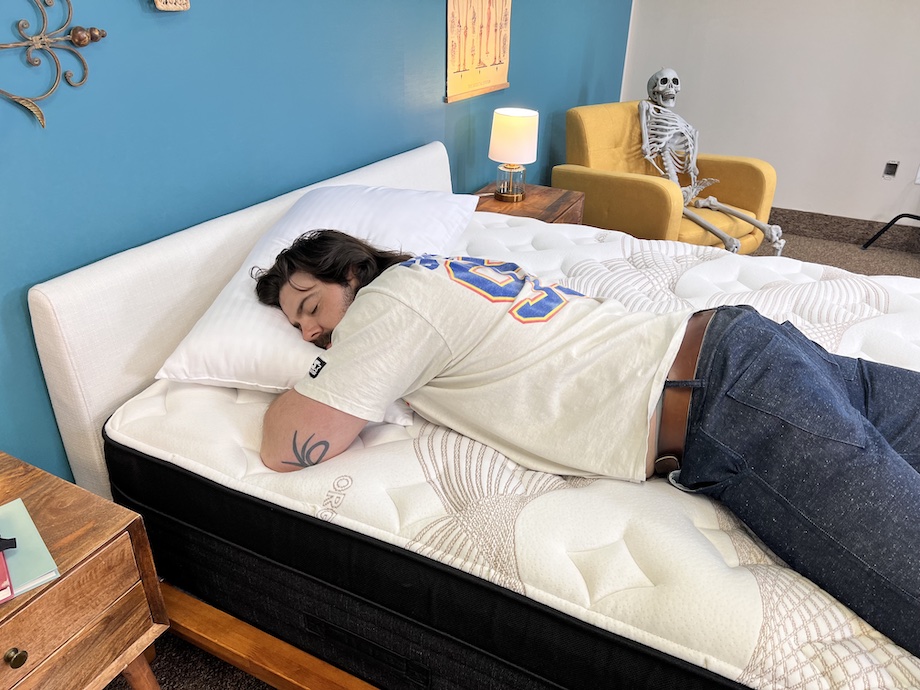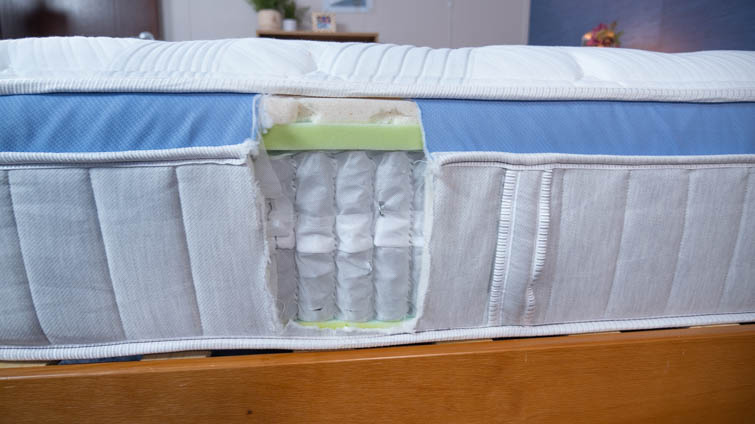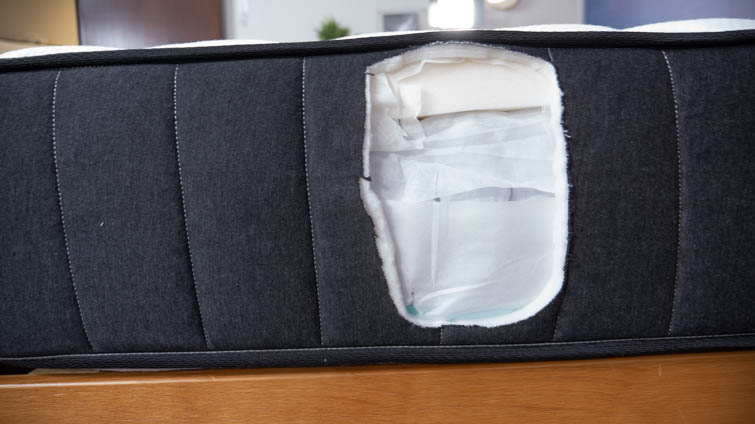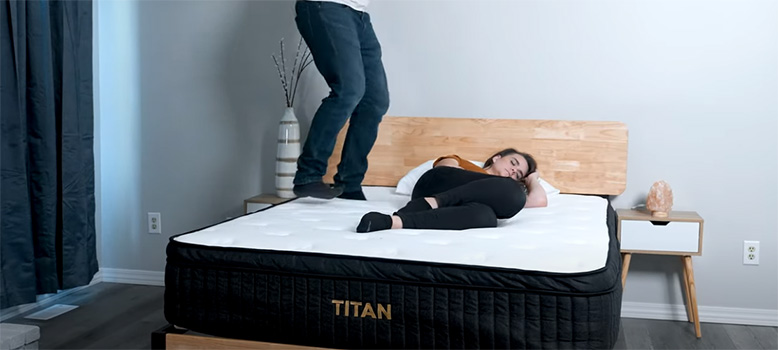Do your hips hurt when you’re lying in bed? Many people struggle with hip pain throughout the night, especially side sleepers, for whom this area is a key pressure point. If you experience this kind of pain, then finding a better bed is one step you can take toward relief.
The best mattresses for hip pain have design features that offer soothing relief to achy joints. In this article, we’ll share our top mattresses for hip pain relief, a shopping guide for finding your new bed, and tips for minimizing nighttime discomfort.
Our Top Pick for The Best Mattress for Hip Pain
The Saatva Rx earned our number-one spot because of its targeted design geared toward pain relief. It’s got two coil units for double the bounce, and earned a perfect score in the pressure relief department. Overall, it should cradle and cushion your hips for a comfortable night’s sleep.
Best Mattresses for Hip Pain
Our Video Review of the Best Mattresses for Hip Pain

Compare The Best Mattresses for Hip Pain

|
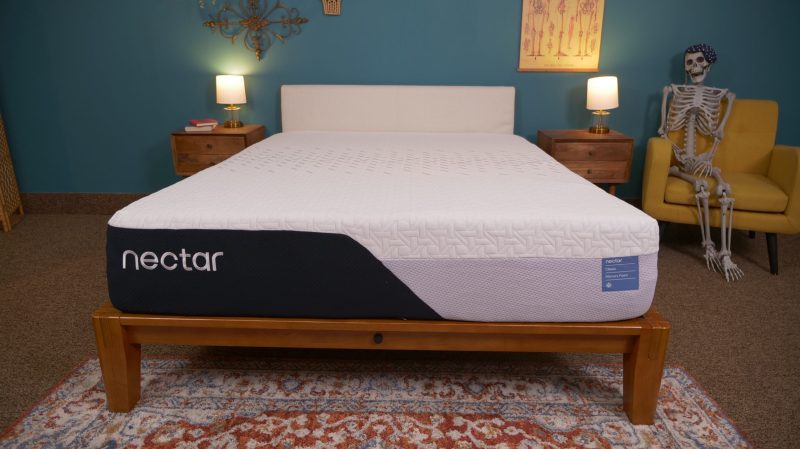
|

|
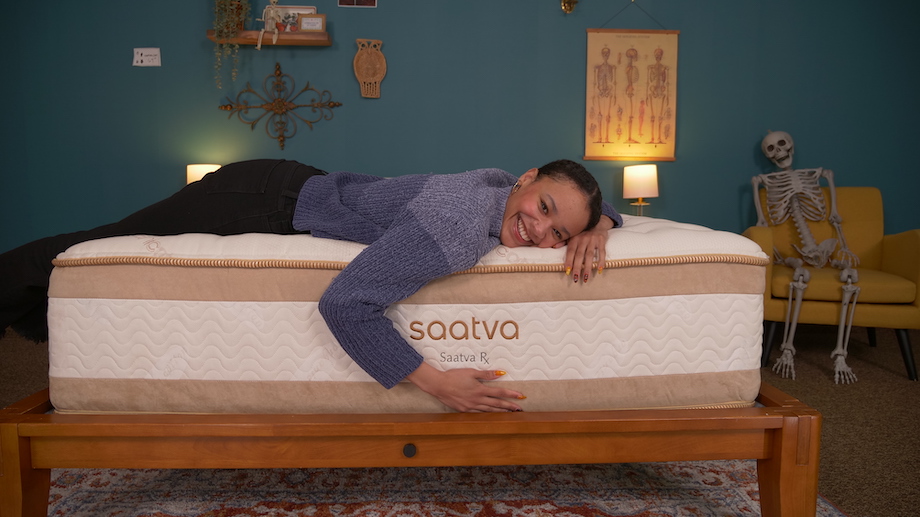
|

|
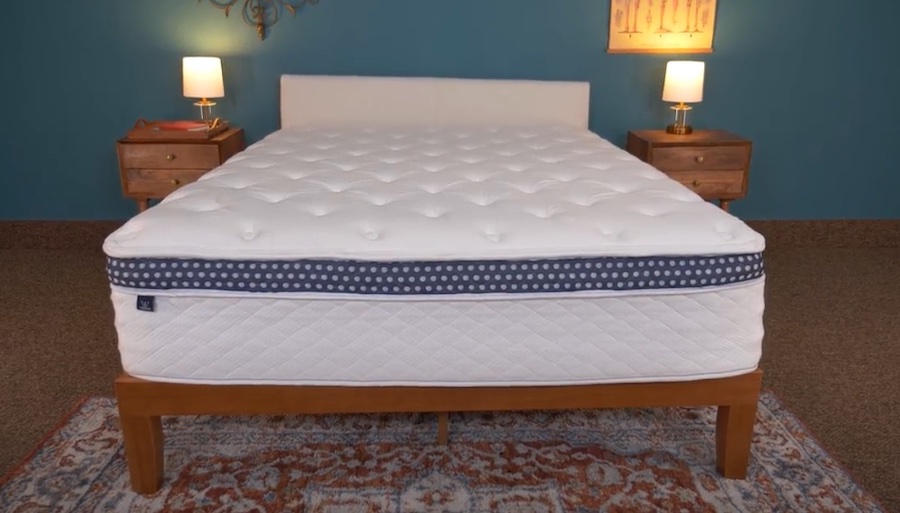
|

|
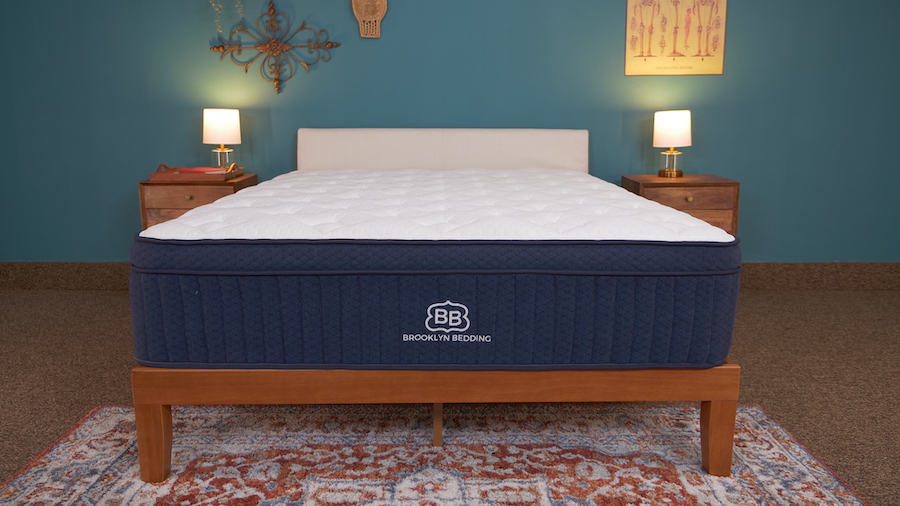
|
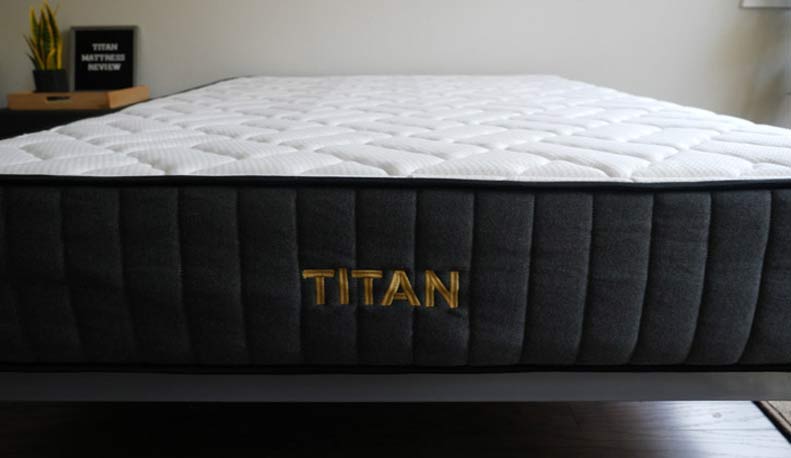
|
|
| Helix Midnight Luxe Mattress | Nectar Mattress | DreamCloud Premier Rest | Saatva Rx Mattress | Nolah Evolution Hybrid Mattress | WinkBed Mattress | Bear Star Hybrid Mattress | Brooklyn Bedding Aurora Luxe Mattress | Brooklyn Bedding Titan Plus Luxe | |
| Rating | |||||||||
| Firmness | Medium-firm: 6/10 | Firm: 7.5/10 | Medium: 5.5/10 | Medium-firm: 6/10 | Multiple firmness options | Multiple firmness options | Medium-firm: 6.5/10 | Multiple firmness options | Medium-firm: 6.5/10 |
| Material | Hybrid | Foam | Hybrid | Hybrid | Hybrid | Hybrid | Hybrid | Hybrid | Hybrid |
| Cooling | — | — | — | — | — | — | |||
| Warranty | 15-year warranty | Lifetime warranty | Lifetime warranty | Lifetime warranty | Lifetime warranty | Lifetime warranty | Lifetime warranty | 10-year warranty | 10-year warranty |
| Shipping | Free shipping | Free shipping | Free shipping | Free white glove delivery | Free shipping | Free shipping | Free shipping | Free shipping | Free shipping minus HI and AK |
| Trial Period | 100 nights | 365 nights | 365 nights | 365 nights | 120 nights | 120 nights | 120 nights | 120 nights | 120 nights |
| Best For | Back Sleepers, Stomach Sleepers, Side Sleepers, Hip Pain, Seniors | Back Sleepers, Back Pain, Stomach Sleepers, Side Sleepers, Couples | Back Sleepers, Side Sleepers, Couples, Hip Pain | Back Pain, Hip Pain, Stomach Sleepers, Side Sleepers, Back Sleepers, Seniors | Side Sleepers, Back Sleepers, Hip Pain, Seniors | Back Sleepers, Stomach Sleepers, Back Pain, Hot Sleepers, Side Sleepers, Hip Pain, Seniors | Joint Pain, Side Sleepers, Back Sleepers, Hot Sleepers | Hot Sleepers, Back Pain, Side Sleepers | Side Sleepers, Back Sleepers |
How We Test the Best Mattresses for Hip Pain
At Sleep Advisor, our mattress reviews are based on findings from in-person tests conducted by our diverse team.
To date, we’ve tested more than 150 beds and helped more than 2,500 people find their next mattress.
We have testers with various body types and sleeping preferences, so we can get a detailed picture of how the mattress will work for just about anyone.
We assign each mattress a score in several performance categories (including support, pressure relief, bounce, and more), then weigh these numbers to produce an overall score.
For this roundup, we prioritized features that are especially important for sleepers with hip pain. We paid special attention to components such as responsiveness, comfort, weight capacity, and pressure relief. More on that below!

What We Look for in a Mattress for Hip Pain
Cushioning Comfort
It’s important that a bed geared toward targeting hip pain should have plenty of cushioning to ensure that sensitive areas remain cradled. A too-firm mattress can exacerbate pain in the hips. We sought out beds that should provide enough contouring to stave off added discomfort.
Spine-Aligning Support
But it’s also important to not have a too-soft mattress, as support is key for aligning your body. Some hip pain might be from your spine being thrown out of whack from laying on a mattress that’s ill-suited to your body type or sleeping preferences. So, we’ve gathered a list of beds that should work to keep you in a comfortable position.
Pressure-Relieving Materials
Though an innerspring bed is great for support and alignment, it’s important that these beds have softer materials on top to take pressure off your hips. Foam or latex is the preferred material, so we tried to pick all-foam beds or hybrids that incorporate these in their comfort layers.
The Best Beds for Hip Pain
Helix Midnight Luxe – Editor’s Pick
The Advisor Says: An upgraded version of the Helix Midnight, this bed added zoned support for more lift beneath the lower back as well as a plush pillow top. It should appeal to people (and back sleepers in particular) who want just a bit of comfy sink from the top layer of their hybrid mattress.
Nectar – Best Memory Foam Mattress for Hip Pain
The Advisor Says: We believe that Nectar offers a quality bed backed up by generous policies, and for under $1,000 for a queen (after discounts). If you’re looking for a firmer foam mattress on a budget, the Nectar Classic has you covered.
DreamCloud Premier Rest – Best Mattress for Side Sleepers with Hip Pain
The Advisor Says: It’s DreamCloud’s softest hybrid offering, and its Euro top feels like a gigantic pillow cushioning your body. That said, it’s not built for people who need tons of support—lightweight side sleepers are probably going to have the best time on this mattress.
Saatva Rx – Best Mattress for Combination Sleepers with Hip Pain
The Advisor Says: The Saatva Rx was built for folks with chronic pain concerns. We think its support and pressure relief should provide soothing comfort. It should work for just about anyone who’s been let down by their mattress and wants to upgrade to a luxurious, sturdy bed with a well-balanced feel.
Nolah Evolution – Best Luxury Mattress for Hip Pain
The Advisor Says: The Nolah Evolution is a team favorite with a highly competitive score spread—our testers gave it at least a 4 out of 5 in every single performance category. It’s definitely a luxury mattress, with the height (and price) to match.
WinkBed – Best Mattress for Back and Hip Pain
The Advisor Says: Our testers often compare the WinkBed to a luxury hotel mattress, which is no surprise given its handcrafted touches and elegant hybrid design. It’s also one of the most customizable beds out there, with a firmness level for every body type.
Bear Star Hybrid – Best Hybrid Mattress for Hip Pain
The Advisor Says: The Bear Star Hybrid touts an enviable medium-firm feel that should appeal to a swath of mattress shoppers, including couples with different preferences looking to “compromise.” We gave this hybrid perfect scores in pressure relief, support, and motion transfer.
Brooklyn Bedding Aurora Luxe – Best Mattress for Hip Pain from Arthritis
The Advisor Says: Brooklyn Bedding’s Aurora Luxe features a swath of cooling features in its quality hybrid construction. We recommend this bed for anyone who wants a firmer, luxurious-feeling bed without the high price tag.
Titan Plus Luxe – Best Mattress for Heavy Sleepers with Hip Pain
The Advisor Says: This is a softer, taller bed than its predecessor, the Titan Plus. It’s designed for plus-size sleepers, but its versatile feel makes it approachable for average-weight sleepers, too. It’s a great choice for couples, even ones with different comfort preferences.
What’s the Best Type of Mattress for Hip Pain?
Memory foam and hybrid mattresses are both good options for sleepers with hip pain—the choice between the two will depend on how you want your bed to feel.
Foam beds tend to prioritize pressure relief and a cozy feeling of being “hugged”, which can be beneficial for sore joints. Hybrids have comfort foams on top but springs at the bottom, so they may feel more bouncy and supportive.
Read more about all the different mattress types below.
Memory Foam Mattresses
Not only are memory foam mattresses popular in the bedding industry, but they also tend to be one of the best options for people experiencing hip issues.
If you’re unfamiliar with memory foam, it’s a material that contours to your body and helps you feel cradled while you sleep. When you lie down, the bed should contour to the shape of your body and help keep your spine in its natural curve.
With memory foam, denser and sharper areas of your body should be well-supported, increasing your chances of a pain-free night of sleep. As you shop for a memory foam bed, remember that even though you want something soft, you should also seek something supportive.
A too-soft, low-density foam could cause your body to sink rather than be cradled. That could throw your spine out of alignment and exacerbate your hip pain.
Hybrid Mattresses
By definition, a hybrid bed can contain any number of materials. Most often, you’ll find varieties that combine an innerspring core with a memory foam top layer. Sometimes you’ll find that the foam sandwiches the coil core, or you’ll see varieties that have both latex and memory foam in addition to the innerspring structure in the center.
Hybrid beds tend to combine the best of both worlds: You get the contouring and cradling of memory foam with the structure and support of a coil base. However, they can also be more expensive, and they may not be soft enough for people who regularly have nerve, joint, or bone pain.
If you decide to get a hybrid, seek out something with a supportive top layer, like medium-density foam. If the foam is too soft, it likely won’t provide support, but if it’s too hard, you may not get pressure relief. The best is to research the product’s construction to see what kind of feel and support it brings.
Latex Mattresses
While we love memory foam, it does have one drawback: it tends to run hot. As your body sinks into the surface of the bed, it can trap heat.
Latex has the same benefits as foam but without heat properties. Make sure you get natural latex sourced from the sap of a rubber tree. This material should help keep you cooler and contains fewer chemicals. By contrast, synthetic latex is petroleum-based.
For those on a budget, natural latex is much more expensive than synthetic latex. If you want to avoid a higher price tag, consider getting a latex mattress that blends natural and synthetic forms.
Innerspring Mattresses
For many people, traditional innerspring mattresses feel too firm, and they develop uncomfortable pressure points. In other cases, out-of-date beds that have begun to sag offer inadequate support. If this sounds like your bed at home, it’s likely time to upgrade.
One option is to go for a hybrid or an innerspring mattress that has incorporated a comfort system that uses foam to cradle your painful joints while the coils offer exceptional support. Coil-on-coil systems that use a layer of pocketed micro coils can also offer a unique blend of body conformance and spine alignment.
What to Look for in a Mattress for Hip Pain
The right mattress may help those with hip pain and knowing what to look for in a bed can optimize your relief. Along with the type of mattress, certain preference-based features can enhance your comfort and overall sleeping experience.
Advice from a Medical Expert
We reached out to Dr. Raj Dasgupta, who has over 20 years of experience in the medical field, to see his thoughts on what key qualities people with hip pain should look for in a mattress.
“To ease hip pain, aim for a mattress that supports your spine well and cushions your hips nicely. Look for one that’s not too hard or too soft (medium firmness is usually a good bet) and made from comfortable materials like memory foam or latex. That way, you can get some relief and hopefully sleep better too.”
The Right Firmness and Feel for Your Hips
Because your hips become concentrated pressure points when you sleep on your side, side sleepers typically need softer mattresses than back and stomach sleepers. If your bed is too firm, you’ll likely experience painful pushback in these zones when you lie down.
That being said, there’s such a thing as “too soft.” You don’t want your mattress to trade crucial support for a plush feel. Make sure that you find the surface cozy and that the bed has quality support materials that will prevent it from sagging and keep your body from sinking too deeply.
If you’re experiencing hip pain, we generally recommend choosing a mattress between a 4 and a 6 on our firmness scale, depending on your sleep position and body weight.
“A mattress can make hip pain worse if it’s too hard and creates pressure points, or if it doesn’t support your spine well, putting extra strain on your hips. But a mattress that’s just right (not too hard or too soft) can help ease hip pain by keeping your spine aligned and reducing pressure.”
Dr. Raj Dasgupta
Firmness and Sleeping Position
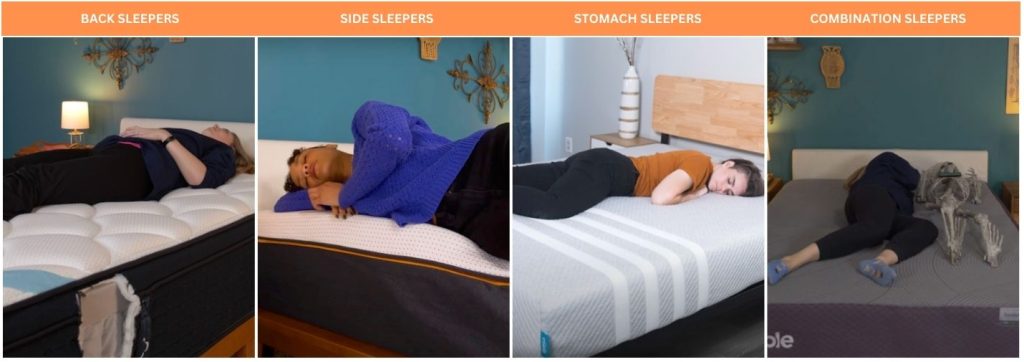
Back sleepers who have hip pain will likely find the most comfort in medium-firm mattresses. This level of support should keep the body supported while still providing pressure relief for the hips.
If you sleep on your side, you will be placing most of your weight on the hips and shoulders, which could increase your pain. While it’s a good idea to avoid sleeping directly on the side with pain, there are some cases in which you may still prefer that particular side. If so, a mattress that cradles these body parts will be important.
Stomach sleepers need to keep their hips elevated. If hips sink too far into the mattress, painful pressure can build up, and this can also lead to poor alignment for the lower back. To avoid this, these sleepers will want a supportive mattress that facilitates good alignment but still gives a slight cushion against the hips.
Combination sleepers will want to sleep on a versatile medium or medium-firm mattress with quick-responding layers that allow them to switch positions more easily.
Firmness and Body Type
How much you weigh and your body type can affect how a mattress responds to you.
Lightweight sleepers with hip pain typically look for softer beds that provide cradling pressure relief around their joints. Those who fall in the middle of the scale will want to look for a mattress that has a medium firmness as this can bring both support and pressure relief.
If you are a heavyweight sleeper who has hip pain, you will likely sleep more soundly on a sturdy, supportive mattress that is on the firmer side.
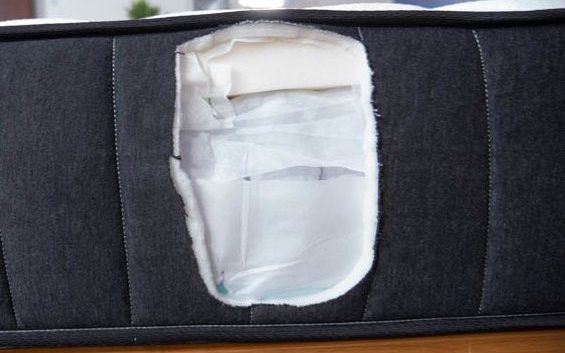
Lots of Pressure Relief
Many people throw the term “pressure relief” around, but if you’re not in the industry, it might not make a lot of sense.
Here’s what’s meant by the term: when we lie down, our weight is heavily concentrated in two body parts – our shoulders and our hips. These are our widest parts, so when we go horizontal, our weight settles here.
If a bed’s surface is either too hard or too soft, it’ll put undue pressure on these areas. When that happens, it can cause pain, numbness, and discomfort. For optimal pressure relief, we recommend mattresses that contain comfort layers containing either memory foam or latex.
Explore: Best Mattress for Shoulder Pain

Support and Spine Alignment
When we’re in bed, our spine should be in proper alignment. What does that mean exactly?
When you lie down, your spine should look the same as it does if you were to view it from someone standing from a straight-on view. To sum up, it should look straight. When your bed is the ideal firmness, and you’re sleeping on the right pillow size, your spine should look straight.
If it’s buckled upward or dipping down, it’s out of alignment, which could lead to more pain.
Motion Isolation
If you are experiencing hip pain, finding a bed that prevents motion from transferring from one area of the bed to the other may decrease pain and provide better quality sleep. This is a particularly important mattress feature for couples and other co-sleepers. If your mattress doesn’t adequately absorb your partner’s movements, not only could it wake you, but it may also exacerbate your pain.
Seniors looking for a supportive mattress should check out our Best Mattresses for Seniors.
Ease of Movement
If your dealing with pain, you’ll want to find a mattress that has plenty of responsiveness and bounce that can help you move about more easily. Innerspring mattresses tend to have a lot of bounce, but they don’t offer the soft cradling that many with hip pain will need. Instead, we recommended a hybrid as an alternative for those who still want an innerspring unit.
Additionally, a latex bed typically has loads of responsiveness that should help you reposition without much effort. Although it may not be as contouring as memory foam, latex should also offer some softness around the hips.
Edge Support
Edge support is a term that speaks to how secure the bed feels when you’re sleeping or sitting on the edge. A sturdy perimeter allows couples to utilize the entire surface and can aid those with mobility issues when getting in and out of bed. Further, for those with hip pain, it can provide an extra level of stability that may prevent you from jerking or twisting in a manner that may make your pain worse.
Durability
It’s easy to find a mattress that feels comfortable for a few nights or months. However, cheaper mattresses may break down over time, and within a few years, they might sag in all the wrong places. A sagging mattress could put undue pressure on the hips resulting in unnecessary discomfort.
If you’re buying a foam mattress, you can seek out something made of a higher-density foam at the core. And if latex is your bed of choice, keep in mind that natural is more durable than synthetic.
For innerspring mattresses, there are different types of coils, and they’re made from different steel thicknesses. Many durable innerspring mattresses will likely have either pocketed coils (individually wrapped) or offset coils. A further advantage of these two coil structures is that they should provide more contouring and conformity than most innerspring designs.
Explore More: Best Mattresses That Don’t Sag
Cooling
Although staying cool may not directly affect your muscle and joint pains, it can be a feature that helps you sleep better. This is important because poor sleep is linked to worse pain symptoms1.
The coils in innerspring and hybrid mattresses and the open-cell structure of latex can prevent body heat from becoming trapped. Although the density of memory foam doesn’t make it great for temperature regulation on its own, many memory foam mattresses are infused with gel or use other technologies to keep it cooler.
Learn more: Best Cooling Mattresses
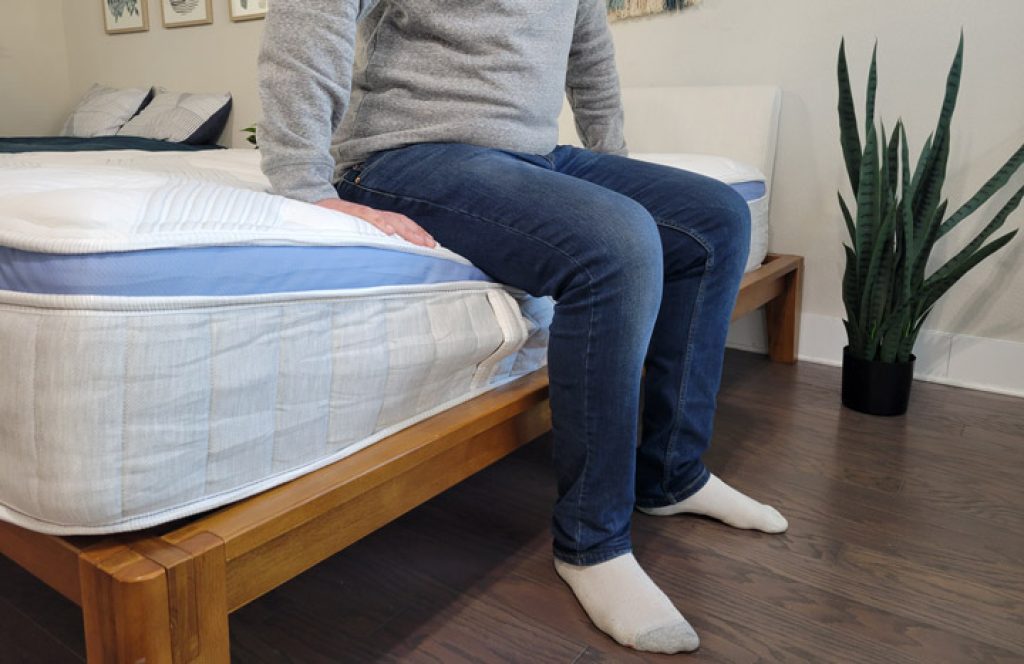
Best Accessories for Hip Pain
Body Pillows
Body pillows can help with hip pain by offering extra support and cradling in this area. These pillows are typically larger than regular pillows we use under the head. However, they come in many shapes, sizes, and firmness levels, allowing you to choose what’s most comfortable depending on the pain you’re dealing with.
Mattress Toppers
A mattress topper can help change the firmness and feel of your mattress without splurging on a new bed. You can go for a softer or firmer topper, depending on what you’re trying to achieve.
A medium firmness is typically the best, but for side sleepers with hip pain, an even softer topper may be a good option. There are many to choose from, and they are made from different kinds of materials to help match your preferences for surface temperature, body conformance, and thickness.
Adjustable Bases
An adjustable base makes it easier to customize how a mattress feels by allowing you to change the angle of the bed. There’s a range of adjustable bases moving in various ways, so you can pick based on how you want your bed to move. One thing to keep in mind is that these bases can be pricey and not every mattress is compatible with an adjustable base.
Explore the best adjustable bases here.
What Causes Hip Pain?
Bursitis
Also known as bursa inflammation, bursitis2 is when the fluid around your joints (hips, knees, shoulders, and elbows) becomes inflamed and causes pain. It can occur at any time of day but is typically worse at night as lying down can put pressure on the affected areas. Pain from bursitis differs from person to person. It may develop suddenly or it may build up slowly over time3.
Sciatica
If you’ve experienced a painful tingling that goes down the side of your leg, it may be a symptom of sciatica4. This condition is a result of inflammation in the sciatic nerve, the nerve that goes from the base of your spine at your lower back down to your feet. It’s typically caused by misalignment and injury and though treatable, is quite painful.
Explore the best mattress for sciatica pain.
Tendonitis
As we age, the tendons that connect our bone and muscle lose their elasticity and, therefore, the ability to provide cushioning and support for force and tension (hence the name, tendons). Combined with physical activity, especially high-impact like running and tennis, the tendons become irritated, resulting in tendonitis5. Proper rest, heat and ice treatments, therapy, and a mattress with adequate support can all reduce the symptoms of tendonitis.
Arthritis
Arthritis is an inflammatory condition of the joints, resulting in pain, weakness, and stiffness where the bones meet. There are several types of arthritis6, the most common being rheumatoid arthritis (RA) and osteoarthritis.
In most cases, the cause is the result of an immune response that triggers the body to attack healthy tissue. Symptoms can occur at any stage in your life but often correlate with age.
Discover our picks for the best mattresses for arthritis.
Osteoarthritis
Osteoarthritis7 is often associated with older adults because it’s the result of overuse and other causes over the years. It occurs as the result of degeneration in a patient’s joint cartilage, though it can also appear as a result of an injury or infection. Osteoarthritis can be painful and cause stiffness, especially in the hips, knees, back, and hands.
Pregnancy
Carrying extra weight around can increase pressure on your entire body, and since the weight is concentrated in a single area, it can result in pain in the hip area8.
In addition to ensuring you have the right mattress, it’s also imperative to sleep in the right position (like side sleeping9) and have adequate support in the form of pillows. Many women have found success with either placing a pillow between the knees or getting a full body pillow designed for pregnancy that helps to ease pressure and discomfort, resulting in a comfortable night of sleep.
Looking to learn more? Check out our guide for Sleeping While Pregnant or explore our picks for the best mattresses for pregnancy.
Tight Muscles
Tightness in a muscle can make you feel sore, especially if you move a certain way or put your body in a position that strains the muscle further. Stretching and rest are two ways to loosen muscles and manage the associated pain.
There are a variety of stretches you can do, but the quickest and easiest one is this:
- Stand in place; cross one foot over the other at the ankle.
- Bend forward to touch your toes. Don’t worry if you can’t get all the way there. Just go as far as you can until you feel a decent stretch.
- Hold for about 30 seconds, and then cross the other foot in front.
This stretch can help ease symptoms of sciatica and loosen the IT band, a tendon that does down the side of your leg and is overly tight on just about everyone, especially those who sit all day at a desk job.
Bowel Problems
Bowel troubles10 like colitis and poor digestion can often also cause hip pain. The reason is that because our body is a connected system, a problem in one area can express itself as pain in another part of the body.
So, while you may not feel pain in your bowel area if you have some type of digestive condition and pain in your hip, the two could be related. Work on fixing that underlying digestive condition to see if it improves pain elsewhere.
For More Info: How Digestion Affects Your Sleep
Soreness from Exercise
Whoever invented the phrase “better sore than sorry” probably never had to sleep with hip pain. Overexerting yourself with exercise, especially of the high-impact variety, may cause lactic acid11 to build up which can make getting a pain-free night of sleep virtually impossible.
If you’re feeling extra sore from a long run, overdoing it at the gym, or helping your old college buddy move across town, you might need to take it easy for a few days. If you can’t bear the thought of missing a workout, try a lower-impact exercise like swimming or walking. And remember to stretch.
How Can a Mattress Help with Hip Pain?
Mattresses can help with hip pain in the following ways:
- Pressure relief – Certain types of mattresses, such as memory foam and latex, can offer those with hip pain pressure relief at night by providing gentle cradling around the affected areas.
- Solid support – Another advantage of a quality mattress is excellent body support to promote a neutral and healthy spine alignment. A supportive bed is important because it can prevent you from sinking too far into a mattress, which could otherwise create more pressure on the hips, as well as back pain.
- Improved sleep – Mattresses for hip pain may improve sleep quality by alleviating your aches and pains. This is vital since worse sleep is linked to increased pain sensitivity.1
What Is the Best Sleeping Position for Hip Pain?
Back Sleeping
If lying on your side hurts no matter which side you try, and you can’t stand the thought of sleeping on your stomach, you may want to try switching to your back.
Although sleeping on your back can help alleviate pain in your hips, it may cause excess pressure on your spine and possibly some issues with your neck. You can help this issue12 by putting a small pillow at the base of your back and using a supportive, ergonomic pillow for your neck.

Another option is a wedge pillow. You can place it directly under your knees, or get a second one to prop up against the headboard to create the effect of a makeshift recliner.
Side Sleeping
Sleeping on your side can put a lot of pressure and weight onto relatively small parts of your body and your mattress may exacerbate these issues, but some experts believe that this is still the best position13 for overall sleep wellness.
However, the bed should have an ideal blend of comfort and support. Again, if the mattress is too firm, the spine can tilt up, especially in the pelvic area. Similarly, a too-soft bed can allow you to sink in too deeply and lose the support you need to stay comfortable and pain-free.
Another reason side sleeping can be ideal is that most people report pain in only one side of their body. If it hurts to sleep on your right side, you can often get relief by switching to your left, and vice versa.
Combination Sleeping
Given the nature of combination sleeping, it can be tricky to find consistent comfort if you’re experiencing hip pain. These sleepers may be served best by finding a versatile medium or medium-firm mattress that is supportive, pressure-relieving, and responsive. Support and pressure relief can help facilitate comfort no matter what position a sleeper is in, and responsiveness can help them reposition without much effort.
Furthermore, depending on the positions that you sleep in, you may be able to use pillows for additional comfort.
Stomach Sleeping
The Cleveland Clinic states that sleeping on your stomach14 is generally not recommended because sleeping on your frontside can lead to neck, back, and shoulder pain. Considering that the midsection is typically one of the heaviest parts of the body, sleeping this way could also cause the sleeper to sink too far down in the bed. This can lead to pressure buildup around this area, as well as poor spinal alignment in the lower back area.
If stomach sleeping is still the most comfortable posture for you, then your mattress should be on the firmer end of the spectrum. If it’s too soft, your hips will likely sink in and cause your back to arch. Now, you might be dealing with some not-so-fun lower back pain to add to the discomfort in your hips.
You can also try putting a pillow either underneath your stomach or pelvis. The cushion can help place your body at a more natural angle.
Tips for Better Sleeping with Hip Pain
- Change up your sleep position – If possible, you may want to switch to sleeping on your back as this can alleviate pressure on your hips.
- Invest in a new mattress – A quality mattress that supports your weight and preferred sleep position may help your hip pain.
- Add a topper – If you are not ready to invest in a mattress, a topper can be an excellent option to make your bed softer or firmer as needed.
- Practice good sleep hygiene – Establishing good sleep hygiene habits might not directly affect your hip pain, but they can help foster better sleep overall, which can help reduce your pain sensitivity.
- Stretch – Gentle stretching before bed15 can help improve performance in the muscles and joints, as well as boost circulation.
Best Mattress for Hip Pain FAQs
Why is my hip pain worse at night?
The stress and movement of the day can build up and peak at night. Then when you lie down and remain still, the hip tends to stiffen. If you combine that with a suboptimal mattress and the wrong sleeping position, it’s a recipe for disaster.
If you lie on your hip, this can also increase the pain level, especially since you’re not moving and allowing blood to circulate and relax the muscles.
Can a mattress cause hip pain?
Yes, a mattress can cause or exacerbate hip pain.
If a mattress is too firm, it may cause soreness around your hips, which are two key pressure points for side sleepers. On the other hand, if a mattress is too soft or lacks proper support, your hips may press too deeply into the bed. This may result in poor spinal alignment and contribute to possible aches and pains.
Therefore, make sure to check our list of the best mattresses to find the one that suits you the best.
Is a soft or firm mattress better for hip pain?
A soft mattress with reliable support is a good option for sleepers with hip pain, particularly those who sleep on their side.
In general, you’ll want the mattress to be soft enough to feel good on your joints but firm enough to promote healthy alignment and support.
Your desired firmness may differ from another person’s, so go with whatever feels good and benefits your hip pain the most.
How can I relieve hip pain when sleeping?
If you experience hip pain when you’re in bed16, try some of these tactics. (Of course, if your hip pain is persistent and prevents restful sleep, you should also always seek the advice of a medical professional.)
- Place a pillow or rolled-up blanket between your legs. This practice can help your spine and pelvis stay in a neutral position that helps take the strain off surrounding tissue. There are even pillows that have been contoured for this specific purpose.
- If you feel pain in one hip, switch to sleeping on the other hip. In general, take pressure off of the most affected areas of your body whenever you can.
- Try sleeping on your back instead of your side. If you’re a lifelong side sleeper, this may feel like a drastic adjustment, but we promise it’s possible to learn how to sleep on your back with practice.
- Purchase a new mattress that will be more comfortable for your hip pain. If you’d rather explore a more budget-friendly option first, you can look at pressure-relieving mattress toppers.
Should I stretch before bed to prevent hip pain?
Stretching is one of the best things you can do before bed. Your chiropractor or physiotherapist can recommend exercises for you to do daily. In addition to the toe-touching stretch mentioned above, a stretch called pigeon can be an effective hip opener.
You can do this exercise either standing, sitting, or lying down. Here are instructions if you’d like to try it lying down:
Supine Pigeon
- Lie flat on your back
- Raise your legs and bend your knees so that they’re at a 90-degree angle
- Cross your right leg loosely over your left knee; your right knee should be pointing out toward the side of the room
- Wrap your arms around the left leg; clasp your fingers if you can
- Gently pull your left leg toward your chest. You’ll feel a stretch in the back of your right leg
- Hold for 30-60 seconds
- Repeat these steps on the other side
Interested in exploring further? Follow our guide for Yoga for Better Sleep.
What if both hips hurt while sleeping?
If both hips hurt simultaneously, it can feel like an impossible task to fall asleep. Stretching and a pain reliever may help. You can also invest in a contoured body pillow that provides superior all-over pressure relief.
If you’re still uncomfortable, you’re going to need some additional help. You may want to try this experiment (and it could even be fun!):
Book a night at a hotel, preferably a good one. Try sleeping in their bed. If you wake up feeling little or no pain, you may have proof that your mattress was the culprit all along!
If you’re hesitant to splurge on a fancy hotel, consider getting a bed with a no-risk trial so you can see if that will make a difference.
Can a mattress topper help with hip pain?
Plusher mattresses with great support systems can greatly reduce the likelihood that you’ll aggravate your pain in the night, but not everyone can stretch their finances towards a brand new mattress at a moment’s notice.
A mattress topper designed for relieving hip pain may be a fantastic alternative that can add just a touch of extra pressure relief to your bed without overextending your budget.
Read More: Best Mattress Toppers for Hip Pain
The Best Mattresses for Hip Pain: Price Comparison Chart
| Mattress | Best For | Price (Queen Size) | Review |
| Helix Midnight Luxe | Editor’s Pick | $2,049 | Helix Midnight Luxe Mattress Review |
| Nectar | Memory Foam | $999 | Nectar Mattress Review |
| DreamCloud Premier Rest | Side Sleepers | $2,499 | DreamCloud Premier Rest Mattress Review |
| Saatva Rx | Combination Sleepers | $3,295 | Saatva Rx Mattress Review |
| Nolah Evolution | Luxury | $2,299 | Nolah Evolution Mattress Review |
| WinkBed | Back Pain | $1,799 | Winkbed Mattress Review |
| Bear Star Hybrid | Hybrid | $1,998 | Bear Hybrid Mattress Review |
| Brooklyn Bedding Aurora Luxe | Arthritis Sufferers | $1,874 | Aurora Mattress Review |
| Titan Plus Luxe | Heavy Sleepers | $1,599 | Titan Plus Luxe Mattress Review |

Julia Forbes
Sleep Advisor Mattress Tester
About Author
Julia specializes in testing out mattresses and sleep accessories – she’s in the right line of work, because she loves to sleep.
Stomach Sleeper
Education & Credentials
- Certified Sleep Science Coach
References:
- Levy Andersen, Monica., et al. “Sleep Disturbance and Pain: A Tale of Two Common Problems”. Chest. 2018.
- Williams, Christopher H., Jamal, Zohaib., Sternard, Britini T. “Bursitis”. National Library of Medicine. Last modified February 20, 2023.
- “Bursitis”. Cleveland Clinic. Last modified March 7, 2023.
- “Sciatica”. Mayo Clinic. Last modified September 13, 2022.
- “Tendonitis”. National Health Service. Last modified July 15, 2020.
- “Arthritis”. Mayo Clinic. Last modified September 15, 2021
- “Osteoarthritis”. Centers for Disease Control and Prevention. Last modified January 26, 2024.
- “Hip Pain During Pregnancy”. Obstetrics and Gynecology Associates of Hampton. 2022.
- Stacey, Tomasina., Mitchell, Edwin A. “Sleep position and risk of late stillbirth”. BMC Pregnancy and Childbirth. 2012.
- Cruz MD, Chris., et al. “Hip Pain Secondary to Small Bowel Fistula to Pelvis”. West JEM. 2014.
- “Lactic Acid: What is lactic acid?”. Cleveland Clinic. Last modified December 9, 2022.
- “Sleeping positions that reduce back pain”. Mayo Clinic. Last modified May 5, 2022.
- Howland, Jason. “Mayo Clinic Minute: What is the best sleeping position?” Mayo Clinic. 2023.
- “Is Sleeping on Your Stomach Bad?”. Cleveland Clinic. 2023.
- “Stretching: Focus on flexibility”. Mayo Clinic. Last modified February 12, 2022.
- Rath, Linda. “Hip Pain at Night?” Arthritis Foundation. 2022.

